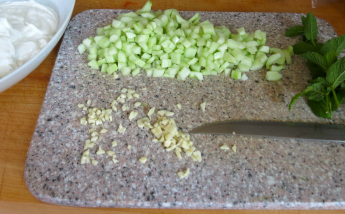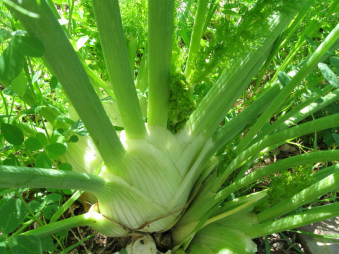 Leaves and flowers of the sassafras tree If you've ever seen a gumbo recipe, you may have been intimidated by the long list of ingredients and the longer list of instructions. In fact, though, gumbo is a forgiving dish. The Cajuns of southern Louisiana have a long history of cooking with whatever foods are in season or available, and the seemingly endless number of gumbo recipes reflect this. The basic structure is simple and adaptable to what you have on hand and your schedule for the day. How simple is a gumbo? This simple:- Make a brown roux.
- Cook the "holy trinity" and the okra (optional) in the roux.
- Add stock.
- Add bay leaves, thyme sprigs, garlic (optional), cayenne (optional), and vegetable (optional).
- Cook until time to eat and vegetables are well cooked.
- Add filé powder.
- Serve on hot rice.
If you are making a nonvegetarian gumbo, there is one additional step: Cook the creature(s) or creature parts and add them at the appropriate time. Duck, turkey, andouille (a hard smoked pork sausage common in Louisiana), tasso (a ham-like smoked pork cut), chicken, and similar meats can stew for a long time, whereas quail, shrimp, crab, and fish should be cooked and added at the last minute.
Now for a few notes on each step.1. Make a brown roux. You probably learned to make a white sauce in your high school Home Ec class. A brown roux is very similar. For a roux for one pot of gumbo, heat 1/2 cup of oil in a cooking pot with a very heavy bottom and then gradually whisk in 1/2 cup of white flour. Whisk constantly until the mixture is the color of peanut butter and smells like roasted nuts. This step is the only tricky part of making gumbo: If you keep the heat too high, you may burn the flour and have to start over. If you keep the heat too low, it will take forever for the roux to darken sufficiently. For a more extended discussion of roux and other ways to make a dark roux, see the instructions at the "Gumbo Cooking" blog, the instructions for Magic Roux Powder, and three roux recipes from restauranteur Alex Patout. 2. Cook the "holy trinity" and the okra (optional) in the roux. The "holy trinity" of southern Louisiana cooking consists of onions, green peppers, and celery, all chopped. You can use equal volumes of each or adjust the proportions to your own taste. You should have 3 to 5 cups total of the "holy trinity" and another 2 to 3 cups of chopped okra, if you are using it. Cook for about 5 minutes or until the veggies have softened. 3. Add stock. For most gumbos, the best stock is a chicken stock or a "no chicken" chicken stock. A vegetable stock without tomatoes also works. Add stock 1 cup at a time to the pot, stirring until the mixture thickens to the consistency of a thick sauce. Keep adding stock in this manner until the mixture has the consistency of a thick stew. Five or six cups of stock should do it. 4. Add bay leaves, thyme sprigs, garlic (optional), cayenne (optional), and vegetable (optional). Again, the quantity of herbs depends on your own taste. It is fine to use dried bay leaves and thyme if you don't have fresh. If you are not using okra in your gumbo, you probably will want to add 2 to 3 cups of a chopped vegetable now. 5. Cook until time to eat and vegetables are well cooked. You can let your gumbo simmer at your convenience for one to four hours. The gumbo will be brownish and the vegetables very soft and nearly indistinguishable from each other. 6. Add filé powder. About a teaspoon for a pot of gumbo is good. Filé powder is the dried and ground leaves of sassafras. You may find it in your regular grocery store with the herbs or with the ethnic foods. Be sure to read the ingredient list to make sure your filé powder contains sassafras and nothing else. Or you may need to try a gourmet grocery store or an upscale health-food store. If you have used okra in your gumbo, you don't need filé powder; each ingredient serves to thicken the gumbo, so most recipes call for one or the other. However, I personally like the flavor of filé and use it even with okra. If you are not a vegetarian, you can add some Worcestershire sauce now. 7. Serve on hot rice. Use converted rice if you can find it. It may be shelved with the regular rice or with the ethnic foods. Converted rice looks, cooks, and tastes much like white rice, but it provides better nutrition and the grains stay nicely separate. Cook 1/2 cup of raw rice per person. You can serve your gumbo over the rice or serve them side by side. Garnish with flat-leaf parsley if you like. In a few days, once my New Orleans friends are home from Hurricane Isaac and have electricity again, I will post a recipe of my own for cactus leaf gumbo. In the meantime, you now know enough to make your own authentic gumbo! If you prefer to follow a recipe, the New Orleans Times-Picayune has five pages of links to recipes for gumbo and other southern Louisiana stews, starting here.—Shauna (sassafras art in the public domain)
 "Is there no Latin word for Tea? Upon my soul, if I had known that I would have let the vulgar stuff alone."
Hilaire Belloc, On Nothing (1908)
Image: La Tasse de Thé, Mary Cassatt (1845–1926), pastel on paper (Image is in the public domain in the United States.)
 Food traveled along the the ancient trade routes of the Silk Road as easily as the rugs, silks, and spices it is better known for.
This recipe is for a Turkish version of the cooling cucumber and yogurt salad that is popular in many places along the old Silk Road. The Turks serve it as is as a meze or as a side dish. It is a perfect dish for the hot summer days most Americans are having now.
 Cacik- 2 cups Greek-style yogurt
- 2 cloves garlic, finely chopped
- dash of salt, if desired
- 1 teaspoon olive oil
- 1 large American or 2 Persian cucumbers, peeled and chopped (if using American cucumbers, remove seeds before chopping)
- 10 fresh mint leaves (or to taste), chopped
- a few fresh mint leaves, whole
Beat the yogurt, garlic, salt, and olive oil in a bowl until the mixture is very smooth. Fold in cucumber pieces and chopped mint leaves until these additions are evenly spread throughout. Transfer to serving dish and chill thoroughly. Serve garnished with mint leaves. Serves 4Common variations in Turkey- Add a squeeze of lemon juice when mixing the cacik.
- Substitute dill for mint.
- For a runny salad, use American-style yogurt.
- Dilute the cacik with ice-cold water and serve as a soup.
- Slice or grate the cucumber instead.
- Use 1 tablespoon of dried mint instead of fresh mint.
- Drizzle top with olive oil before serving.
—Shauna Cacik recipe by Shauna Roberts. Cacik pictured prepared by David Malueg. Photos copyright 2012 Shauna Roberts.
 Next time you get near a lentil, hold it up sideways and squint. You'll see that it's shaped just like a lens, with two hard, convex shells enclosing the starchy interior. Our word lentil comes, via French lentille, from Latin lenticula, "little lentil;" the ordinary Latin word for lentil is lens (plural lentes.) But lentils weren't given that lens-ey name because they were lens-shaped. It was the other way around: 17th century scientists gave the name lens to the biconvex things that they were experimenting with, because they were shaped like lentils! When I was younger and more innocent, I was convinced that lentils were a progressive, modern food, invented sometime around the Summer of Love. Totally wrong. Lentils were thoroughly unfashionable in the early twentieth century, but they have been one of the staple foods of Europe from Neolithic times, usually served to the happy peasantry in the form of stew or soup. The ancient Greeks lived on lentil soup and barley bread or barley polenta, plus vegetables, wheat bread and fish, with meat as an occasional luxury. Even more startling: our ancestors were eating lentils long before they domesticated them in the Neolithic. Wild lentils were being gathered and eaten by the Palaeolithic inhabitants of Greece 12,000 years ago. I have always been attracted to the remarkably healthy lentil, but I had so many disappointing lentil slices, lentil pies and lentil stews served by self-consciously Health Food establishments that I almost gave up. But if you cook lentils the old-fashioned way, they are quite delicious. My favourite recipe is a French peasant recipe for Warm Lentil Salad adapted from Patricia Wells' excellent recipe in her wonderful French cookbook Bistro Cooking; I'm sure that something very like it has been made continuously around the Mediterranean since the Neolithic, and called Lentil Stew. It sounds a lot like what Aristophanes might have gone home to after a hard day of writing bawdy plays. Always use the best lentils you can find. They're so cheap that even the most expensive, once they're expanded with water, still make a remarkably cheap meal or side dish. The cheapest are large and coarse and tasteless; the best I've tried are the tiny, dark-grey Puy lentils either actually imported from France or grown locally (for those who worry about food miles). Where possible, buy pulses from places with a high turnover. They are definitely not improved by years of storage. Warm Lentil Salad 2 cups lentils (grey or greeny-brown, NOT split red lentils, or the recipe will turn to sludge) 6 cups water 1 to 4 cloves of garlic (to taste), peeled and crushed 1 onion, peeled and quartered 3 or so bay leaves, fresh or dried (Olympic victors were crowned with wreaths of bay leaves) Sprigs of herbs: parsley, rosemary, marjoram, and/or thyme, if you have them in the garden Dressing: 1/4 cup red wine vinegar 2 tablespoons olive oil one or two teaspoons salt and a good grind of black pepper 1. Place lentils, water, garlic, onion and herbs in a large heavy-based saucepan. Heat gently until simmering. Keep at a gentle simmer, checking that there is enough water and adding more as needed, until lentils are tender. The amount of water will vary according to how old and dry the lentils are. 2. When lentils are tender, drain any excess water. Pour into a serving bowl. Mix dressing in a small jar and shake. Pour dressing over lentils and stir gently. Serve. We often eat this as a main course, but it is a great accompaniment to a roast, or to an assortment of other vegetarian dishes. It can be tempting to add other healthy things, like celery and carrot, but please resist the temptation. Delicious as they are in their own right, they make the finished dish far too much like health food. Mushrooms can be a good addition; they add a rich texture, and are authentically ancient. Optionally, you can add a can of tomatoes (unknown in Europe before Columbus), omit the vinegar, heat well, and call it lentil soup. Float basil leaves on top if you have any. - Jenny(I copied the photo from the Wikipedia entry of lentils; it's licensed under Creative Commons as - Description: red, green and puy lentils
- Photographer: User:Justinc)
 Emperor Kangxi (康熙帝), 1654–1722 Emperor Kangxi (康熙帝), 1654–1722 One of China's greatest emperors is remembered today in the West primarily for a banquet he hosted that had 108 courses and more than 2500 guests. Kangxi, the fourth emperor of the Qing Dynasty, deserves to be known for more. The highlights of his 61-year reign include military victories, infrastructure improvements, literary commissions of important works, long-term stability and peace in China, invention of a calendar, and efforts to encourage the Manchu and the Han people to live peaceably together under united rule. The last of these achievements led to the famous feast that Kangxi called Man Han Quan Xi, meaning the Manchurian and Han Banquet. I first heard of this banquet in a blog post by my friend Mingmei Yip, and I knew I had to find out more about it for "Meal Times." This imperial feast celebrated Emperor Kangxi's 66th birthday. An admirer of the Han culture and eager as emperor to unite the Manchu and Han people, he requested that the banquet feature the best of Manchu cuisine and Han cuisine, which differed greatly in style, ingredients, and cooking methods."Lavish" doesn't begin to describe the resulting banquet. The chefs traveled for three months to collect exotic ingredients such as bear front paws, rhinoceros tails, ape lips, and and leopard fetuses. An army of cooks slaved for three weeks to prepare the banquet. Tablecloths, seat covers, and elaborate clothes for the waitresses had to be sewed and embroidered. The guests—separated by rank but not by ethnicity—sat down at tables dressed with brilliant yellow silk tablecloths and fine tableware of bronze and porcelain. Before the first sip of tea, before the first sighting of the costly food beautifully arranged, every guest had already been overwhelmed by the emperor's wealth, status, and taste. Then the food and wine started coming. And coming. And coming. The feast started with apples and oranges served with seeds and nuts. The many dozens of dishes that followed ranged from the ordinary (such as rice, dumplings, Peking duck, egg tart, and roast chicken), to the unusual (bear paw with sturgeon, dried sea cucumbers), to the offputting (brains of still-living monkeys). Kangxi's Manchurian and Han Banquet proved so popular that it was replicated during the Qing Dynasty and later. Regional variations sprouted up. Today in China, some restaurants still offer a version of the feast, but only the richest people can afford it. —Shauna
Coming in Spring 2012  Prometheus stole fire from the gods with a fennel stalk. We are starting "Meal Times: Ancient Foods for Modern Cooks" ( http://ancientmealtimes.weebly.com) because we love cooking, history, and archaeology. Come back in spring 2012 to read about the food eaten by ancient and prehistoric people; domestication of crops and animals; sauces from around the world; food customs; ancient manners; banquets; history of food-preparation techniques; how archaeologists study diet; growing herbs; etymology of food words; folk tales about food; and much more. We also will feature guest posts by experts in food and cooking. Our focus will be on food and customs of prehistory, ancient Mesopotamia, ancient Egypt, ancient Greece, ancient Rome, medieval Europe and the Middle East, and pre-invasion Americas. However, don't be surprised to find posts on any part of the world or any time period. If it involves history and food, we're interested.
Categories All
Announcement
Meal Times
|







 RSS Feed
RSS Feed